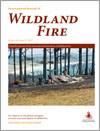International Journal of Wildland Fire
Volume 26
Number 9 2017
This study monitored wildfire effects for a decade following forest fires, and highlights the use of fractional cover mapping over multiple spatial scales. Char cover was the primary field and remotely sensed indicator of high burn severity for the first full year after the fire. The ecological response trajectory varied depending on the degree of initial disturbance; however, all sites had significant understorey vegetation cover after a decade.
This paper studies burnt forest areas for 2010 wildfires in the Republics of Mari El and Chuvashia of the Russian Federation with the use of Landsat time series images. The use of differenced Normalized Burn Ratio (dNBR) and Composite Burn Index (CBI) provided a valuable approach for estimating burnt severity levels.
Fire can affect the relative amounts of carbon and nutrients in the soil–plant system. In Australian eucalypt forest sites, we found that recent fire was associated with a shift in the balance of soil carbon, nitrogen and phosphorus that favoured phosphorus. This suggests that fire enhances the cycling of nutrients, and particularly of P, in low-phosphorus ecosystems.
We developed a landscape-level fire risk assessment approach that integrates fire occurrence probability, fire spread and government-appraised land values. A spatial point processing method was used to generate a spatial distribution of probability density of fire occurrence, and Monte Carlo fire spread simulation was carried out to compute burn probability across a landscape.
The McArthur Forest Fire Danger Index is currently used in Australia to assess bushfire hazard. The index relies on the Keetch–Byram Drought Index to estimate soil dryness, yet improved approaches for estimating soil moisture have become available. This article evaluates the effect of employing alternative soil moisture estimates on the bushfire hazard index.
This study examines wildfire risk awareness and wildfire prevention in a predominantly Indigenous Māori community in New Zealand’s Far North where fire use is prevalent. Participants were aware of the high wildfire risk, and although some efforts were made to use fire safely, instances of unsafe fire use were identified. Factors that influenced awareness and wildfire prevention are discussed.
The standard procedure when simulating fire spread is to take the unperturbed wind flow as input data. In this work, we propose a new formulation that considers thermal effects from the fire front on the wind field. The first part of this work describes the underlying models and preliminary tests.




